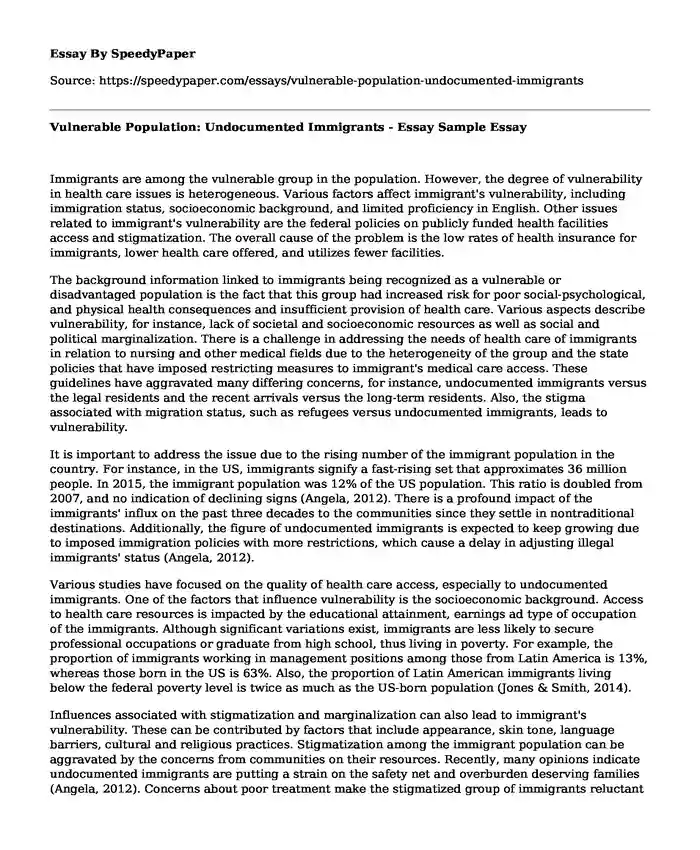
| Type of paper: | Essay |
| Categories: | Economics Immigration Society Healthcare |
| Pages: | 3 |
| Wordcount: | 686 words |
Immigrants are among the vulnerable group in the population. However, the degree of vulnerability in health care issues is heterogeneous. Various factors affect immigrant's vulnerability, including immigration status, socioeconomic background, and limited proficiency in English. Other issues related to immigrant's vulnerability are the federal policies on publicly funded health facilities access and stigmatization. The overall cause of the problem is the low rates of health insurance for immigrants, lower health care offered, and utilizes fewer facilities.
The background information linked to immigrants being recognized as a vulnerable or disadvantaged population is the fact that this group had increased risk for poor social-psychological, and physical health consequences and insufficient provision of health care. Various aspects describe vulnerability, for instance, lack of societal and socioeconomic resources as well as social and political marginalization. There is a challenge in addressing the needs of health care of immigrants in relation to nursing and other medical fields due to the heterogeneity of the group and the state policies that have imposed restricting measures to immigrant's medical care access. These guidelines have aggravated many differing concerns, for instance, undocumented immigrants versus the legal residents and the recent arrivals versus the long-term residents. Also, the stigma associated with migration status, such as refugees versus undocumented immigrants, leads to vulnerability.
It is important to address the issue due to the rising number of the immigrant population in the country. For instance, in the US, immigrants signify a fast-rising set that approximates 36 million people. In 2015, the immigrant population was 12% of the US population. This ratio is doubled from 2007, and no indication of declining signs (Angela, 2012). There is a profound impact of the immigrants' influx on the past three decades to the communities since they settle in nontraditional destinations. Additionally, the figure of undocumented immigrants is expected to keep growing due to imposed immigration policies with more restrictions, which cause a delay in adjusting illegal immigrants' status (Angela, 2012).
Various studies have focused on the quality of health care access, especially to undocumented immigrants. One of the factors that influence vulnerability is the socioeconomic background. Access to health care resources is impacted by the educational attainment, earnings ad type of occupation of the immigrants. Although significant variations exist, immigrants are less likely to secure professional occupations or graduate from high school, thus living in poverty. For example, the proportion of immigrants working in management positions among those from Latin America is 13%, whereas those born in the US is 63%. Also, the proportion of Latin American immigrants living below the federal poverty level is twice as much as the US-born population (Jones & Smith, 2014).
Influences associated with stigmatization and marginalization can also lead to immigrant's vulnerability. These can be contributed by factors that include appearance, skin tone, language barriers, cultural and religious practices. Stigmatization among the immigrant population can be aggravated by the concerns from communities on their resources. Recently, many opinions indicate undocumented immigrants are putting a strain on the safety net and overburden deserving families (Angela, 2012). Concerns about poor treatment make the stigmatized group of immigrants reluctant to seek health care. In case the health providers lack enough resources to attend to the immigrant population, frustrations and extended delays affect the patients as well as the providers. Discrimination reports in health care facilities indicate more complaints from immigrants than US-born citizens. Stigmatization also creates the fear that health providers may breach their privacy, which is unethical. (Jones & Smith, 2014).
Immigrant health deteriorates over time in the US. Factors that account for this issue include unhealthy habits, living conditions, and poor access to health care facilities. Reduction in access to public health programs such as immunization is a risk factor too. Despite the recent influxes of immigrants, many public health systems are less equipped to handle the population. These cause significant implications for immigrants' health, their families, and, subsequently, the whole state.
References
Angela, P. (2012). Influence of transcultural factors on immigrants' populations' needs and nursing diagnosis. Cultura de Los cuidados, 16, 62–67. https://doi.org/10.14198/cuid.2004.16.11
Jones, M., & Smith, P. (2014). Population-focused nursing: advocacy for vulnerable populations in an RN-BSN program. Public Health Nursing, 31(5) https://doi.org/10.1111/phn.12114
Cite this page
Vulnerable Population: Undocumented Immigrants - Essay Sample. (2023, Dec 28). Retrieved from https://speedypaper.net/essays/vulnerable-population-undocumented-immigrants
Request Removal
If you are the original author of this essay and no longer wish to have it published on the SpeedyPaper website, please click below to request its removal:
- College Dropouts Because of Unplanned Pregnancy, Essay Sample
- Nutritional Thread Responses in Our Free Essay
- Essay Sample on Solitary Confinement and Mental Health in the U.S
- Mike's Diabetes Journey: Examining and Managing Type 2 Diabetes - Essay Sample
- Essay Sample on Alcoholics Anonymous Support Group Program
- Free Paper Sample on Leadership Management Strategies
- Importance of Medical Research Funding - Paper Sample
Popular categories




